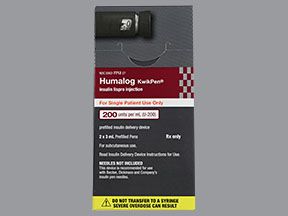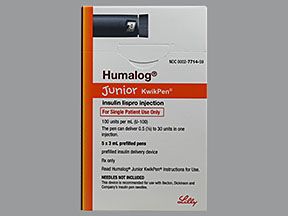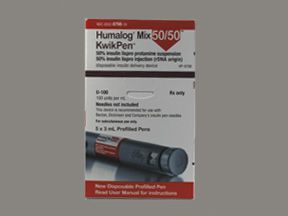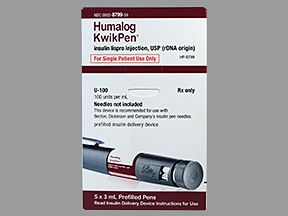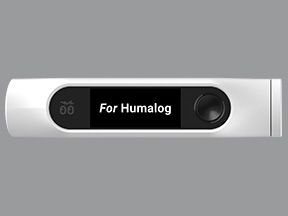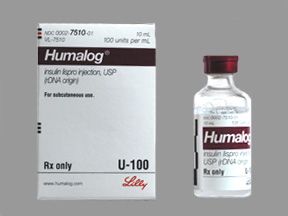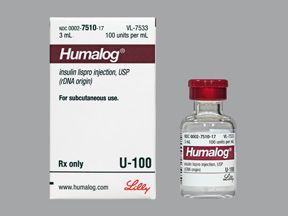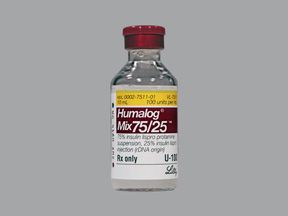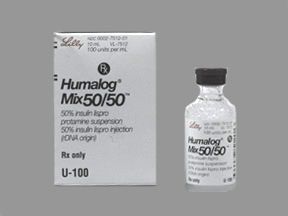Humalog (insulin lispro) is a prescription brand-name medication. The Food and Drug Administration (FDA) has approved it to help manage blood sugar levels in people with diabetes. This includes type 1 and type 2 diabetes.
Humalog is given as an injection, and there are two types of the drug:
- Humalog contains a type of insulin called insulin lispro, which is a rapid-acting insulin analog. An insulin analog is an artificial version of the insulin that’s naturally made by your body.
- Humalog Mix contains a combination of two types of insulin: insulin lispro and insulin lispro protamine, a longer-acting insulin.
Some forms of Humalog and Humalog Mix are available as generics or biosimilars. To learn more, see “Generic or biosimilar versions” in the “Humalog dosage” section below.
For information about the dosages of Humalog and Humalog Mix, including their forms, strengths, and how to use these medications, keep reading. For a comprehensive look at Humalog and Humalog Mix, see this article.
This article describes typical dosages for Humalog and Humalog Mix provided by the drugs’ manufacturer. When using Humalog or Humalog Mix, always follow the dosage prescribed by your doctor.
Read about the forms, strengths, and dosages of Humalog and Humalog Mix.
Humalog is a liquid solution that’s typically given as a subcutaneous injection. The drug can also be given as an IV infusion infusion by a healthcare professional.
Humalog Mix is a liquid suspension. It’s given as a subcutaneous injection.
Humalog forms and strengths
Humalog is approved to treat type 1 and type 2 diabetes in adults. The drug comes in several different forms and strengths:
- Vial. Humalog vials can be used with insulin pumps or insulin syringes. The vials are available in two sizes: 3 milliliters (mL) and 10 mL. The vials come in one strength: U-100. (This is an abbreviation for 100 units of insulin per mL.)
- Humalog KwikPen. This is a prefilled injection pen that’s disposable. It’s available in one size: 3 mL. The Humalog KwikPen comes in two strengths: U-100 and U-200. (U-200 is an abbreviation for 200 units of insulin per mL.) This pen can provide up to 60 units of Humalog per injection.
- Humalog Tempo Pen. This is a prefilled injection pen that’s disposable. It’s available in one size: 3 mL. The Humalog Tempo Pen comes in one strength: U-100. This pen can provide up to 60 units of Humalog per injection.
- Humalog Junior KwikPen. This is a prefilled injection pen that’s disposable. It’s available in one size: 3 mL. The Humalog Junior KwikPen comes in one strength: U-100. This pen can provide up to 30 units of Humalog per injection.
- Cartridge. Humalog cartridges are used in reusable insulin pens.* The cartridges are available in one size: 3 mL. They also come in one strength: U-100.
* Reusable insulin pens, such as HumaPen Luxura, aren’t included with the cartridges and must be purchased separately.
Humalog Mix forms and strengths
Humalog Mix is approved to treat type 1 and type 2 diabetes in adults.
Humalog Mix contains a combination of two different insulins. One is insulin lispro, a rapid-acting insulin. The other is insulin lispro protamine, an intermediate-acting insulin.
There are two Humalog Mix products. Each contains a fixed combination of insulins:
- Humalog Mix 50/50 contains a mixture of 50% insulin lispro protamine and 50% insulin lispro.
- Humalog Mix 75/25 contains a mixture of 75% insulin lispro protamine and 25% insulin lispro.
Humalog Mix 50/50 and Humalog Mix 75/25 come in two forms:
- Vial. Humalog Mix vials are used with insulin pumps or insulin syringes. The vials come in one size: 10 mL. The vials are also available in one strength: U-100.
- Humalog Mix KwikPen. This is a prefilled injection pen that’s disposable. It comes in one size: 3 mL. The Humalog Mix KwikPen comes in one strength: U-100.
Generic or biosimilar versions
Eli Lilly, the manufacturer of Humalog, also makes
- insulin lispro injection vial
- insulin lispro injection KwikPen
- insulin lispro injection Junior KwikPen
- insulin lispro protamine and insulin lispro injectable suspension mix 75/25 KwikPen
If you’d like to learn about the biosimilar versions, talk with your doctor or pharmacist.
Typical dosages
Dosage ranges can vary from person to person. Typically, your doctor will start you on a low dosage. Then they’ll adjust it to reach the amount that manages your blood sugar. There’s no average or maximum dose for Humalog. Your doctor will ultimately prescribe the lowest dosage that provides the desired effect, but this is highly individualized.
The following information describes dosages that are commonly used or recommended. However, be sure to use the dosage that your doctor prescribes for you. Your doctor will determine the best dosage to fit your needs.
Dosage for type 1 diabetes
There isn’t an exact dosage of Humalog or Humalog Mix recommended for people with type 1 diabetes. This is because the recommended dosage depends on many factors that vary with each person. For more information about this, see the “Factors that can affect your dosage” section below.
The American Diabetes Association (ADA) provides some dosage guidelines based on your body weight in kilograms (kg). The ADA recommends that the typical insulin dosage for people with type 1 diabetes is 0.4 units/kg to 1.0 unit/kg each day.
If you have type 1 diabetes, you’ll likely have 50% of your daily insulin dose at mealtimes using Humalog or another rapid-acting insulin. The rest of your daily insulin dose will usually come from long-acting insulin that you inject once or twice daily.
Here’s an example of a Humalog dose chart for an adult with type 1 diabetes:
| Body weight | Prescribed total daily insulin dosage | Total daily insulin dose | Starting daily dose of Humalog |
| 186 pounds (about 85 kg) | 0.8 units/kg | 68 units | 34 units |
You’ll likely use Humalog up to 15 minutes before a meal or right after a meal. The dosage of Humalog that you’ll need may vary from one dose to the next.
Your doctor will show you how to calculate your Humalog dosage. Your dosage is mainly based on:
- your pre-meal blood sugar level
- the amount of carbohydrates in the meal you’re about to eat or just finished eating
- how physically active you’ll be in the next few hours
If you’re using Humalog with an insulin pump, your doctor will explain how to use the medication.
Dosage for type 2 diabetes
There isn’t an exact dosage of Humalog or Humalog Mix recommended for type 2 diabetes treatment. This is because the recommended dosage depends on many factors that vary with each person. For more information about this, see the “Factors that can affect your dosage” section below.
Not everyone who has type 2 diabetes needs to use insulin. But if you and your doctor decide that you need insulin to help manage your blood sugar levels, then you’ll likely start with a long-acting insulin. You’ll usually use it once or twice per day.
In some cases, the long-acting insulin may not manage your blood sugar levels well enough. If this occurs, your doctor will typically add on a rapid-acting mealtime insulin, such as Humalog. They may have you start with a Humalog dose 15 minutes before your largest meal of the day or right after it. If your blood sugar needs to be managed further, your doctor may instruct you to add doses before other meals.
When starting treatment with Humalog or another rapid-acting insulin, the ADA has specific recommendations. The ADA recommends a starting dose of 4 units or 10% of your total daily long-acting insulin dose. Your doctor will help determine the starting dose that’s best for you.
If you have any questions about your Humalog dosage, talk with your doctor.
Long-term use
Humalog is meant to be used as a long-term treatment. If you and your doctor determine that Humalog is safe and effective for you, you’ll likely use it long term.
Children’s dosage
The Food and Drug Administration (FDA) has approved Humalog for use in children ages 3 years and older with type 1 diabetes.
Humalog hasn’t been studied in children younger than 3 years. The drug also hasn’t been studied in children with type 2 diabetes.
Humalog Mix is not approved for use in children.
If you have questions about your child’s Humalog dosage, talk with their doctor.
Learn answers to commonly asked questions about Humalog.
Is there a dosage scale for Humalog?
There isn’t a one-size-fits-all dosage scale for Humalog. Dosages of the drug vary from person to person. Mealtime insulin dosages depend on many factors, such as your blood sugar level before the meal and what foods are in the meal.
For example, there may be times when your pre-meal blood sugar is high and your meal contains several servings of carbohydrates. In such situations, you’ll likely need a higher dose of Humalog than when your pre-meal blood sugar was average and your meal contained no carbs.
If you have additional questions about your Humalog dosage, talk with your doctor.
Can I use Humalog at bedtime?
No, you shouldn’t use Humalog at bedtime. The drug is a rapid-acting insulin and is meant to be used up to 15 minutes before a meal or right after a meal.
Using Humalog at mealtimes helps you manage your blood sugar throughout the day. The drug won’t manage your blood sugar overnight because it wears off after a few hours.
The type of insulin that’s usually used at bedtime is long-acting insulin, such as insulin glargine (Basaglar, Lantus). Long-acting insulin helps manage blood sugar levels for up to 24 hours.
If you have more questions about what times of day to use Humalog, talk with your doctor.
How does the dosage of Humalog compare with that of Humulin R and Novolog?
Humalog (insulin lispro) and Novolog (insulin aspart) are both rapid-acting insulins. Humulin R (insulin human) is a short-acting insulin.
Short-acting insulin typically enters the bloodstream within 30 minutes of you using it and lasts for about 3 to 6 hours. Rapid-acting insulin usually starts working about 15 minutes after you use it and lasts for 2 to 4 hours.
If your doctor has you switch from one of these products to another, it’s likely that your total daily insulin dosage will stay about the same. Be sure to follow the dosage instructions from your doctor.
If you have questions about your Humalog dosage or other insulin products, talk with your doctor.
Is Humalog fast-acting?
Yes, Humalog is a fast-acting insulin that contains the active drug insulin lispro. (Fast-acting insulins are also called “rapid-acting” insulins.) The drug typically starts working within 15 minutes of a dose, and the effects last for about 4 to 6 hours.
Insulin medications are classified by how long they take to start working and how long their effects last. They can be fast-acting, intermediate-acting, or long-acting.
Humalog Mix contains two different types of insulin: insulin lispro and insulin lispro protamine. Insulin lispro is a fast-acting insulin. However, insulin lispro protamine is an intermediate-acting insulin. Due to the mix of the different insulins, Humalog Mix starts working within 15 minutes and its effects last for about 22 hours.
Your doctor or pharmacist can give you more information about what type of insulin Humalog and Humalog Mix are.
The Humalog dosage that your doctor prescribes will depend on several factors. These include:
- the form of Humalog you use
- the type and severity of your diabetes
- other medications you take
- other medical conditions you have
- your weight
- your routine, including diet and exercise
- your blood sugar goals
Dosage adjustments
Your Humalog dosage may need to be adjusted at times. If any of the above factors change, it can affect how much insulin you need to manage your blood sugar levels. Here are a few common examples.
If you gain weight, you may need a higher Humalog dosage than before. And if you lose weight, you may need a lower Humalog dosage than before.
If your doctor has prescribed a corticosteroid, such as Deltasone (prednisone), you may need a higher Humalog dosage than before. This is because corticosteroids can increase your blood sugar levels as a side effect.
Also, your Humalog dosage may need to be temporarily adjusted during times of stress or when you get sick. This is especially important if you develop an infection, have a fever, or aren’t eating.
If you have questions about how your doctor may adjust your Humalog dosage, talk with them.
Make sure to follow the instructions that your doctor or another healthcare professional gives you for using Humalog.
Humalog is a liquid solution that’s typically given as a subcutaneous injection. The drug can also be given as an IV infusion by a healthcare professional.
Humalog can be used in an insulin pump. This is a device that delivers a continuous dose of insulin, and it can also give extra doses at meals.
Humalog Mix can be given only as a subcutaneous injection. It can’t be used in an insulin pump.
Before you start using Humalog, a healthcare professional will teach you how to inject it. But here are a few important tips to keep in mind:
- There are specific spots where you should inject Humalog or Humalog Mix. These are just under the skin of your buttocks, upper leg, abdomen (belly), or back of your upper arm.
- It’s important to rotate injection sites. Using the same spot over and over for insulin injections may cause you to develop lipodystrophy (lumps, pitting, or thickening of the skin).
- You shouldn’t inject Humalog into a vein or muscle. You also shouldn’t inject the drug into skin that’s bruised, scarred, or damaged.
Humalog vials, pens, and cartridges come with step-by-step guides about how to use them. Instructional videos are available on the manufacturer’s website. You can refer to the “Instructions for use” for your particular Humalog product.
You’ll usually use Humalog up to 15 minutes before eating a meal. But if you forget, you can still have your dose right after you finish your meal.
If you forget a Humalog dose and it’s been more than 1 hour since you ate, you should wait until it’s time for your next scheduled dose. Using Humalog more than 1 hour after eating could result in you having hypoglycemia (low blood sugar).
If you receive Humalog from a healthcare professional, reschedule any missed appointments as soon as possible.
To help make sure that you don’t miss a dose, try using a medication reminder. This can include setting an alert on your phone or downloading a reminder app. A kitchen timer can work, too.
If you use more Humalog than your doctor prescribes, you may develop serious side effects.
It’s important that you don’t use more Humalog than your doctor recommends.
Symptoms of an overdose
Overdose symptoms of Humalog can include:
- hypoglycemia (low blood sugar), which can cause:
- shakiness
- dizziness
- slurred speech
- hypokalemia (a low potassium level in your blood), which can cause:
- muscle cramping
- feeling weak
- a fast or irregular heartbeat
If you take more than the recommended amount of Humalog
Call your doctor right away if you believe you’ve used too much Humalog. Another option is to call the American Association of Poison Control Centers at 800-222-1222 or use its online tool. If you have severe symptoms, immediately call 911 or your local emergency number, or go to the nearest emergency room.
The dosages in this article are typical ones provided by the drug manufacturer. If your doctor recommends Humalog for you, they will prescribe the dosage that’s right for you. Always follow the dosage that your doctor prescribes for you.
As with any drug, never change your dosage of Humalog without your doctor’s approval. If you have questions about the dosage that’s right for you, talk with your doctor.
Besides learning about dosage, you may want other information about Humalog. These additional articles might be helpful to you:
- More about Humalog. For information about other aspects of Humalog, refer to this article.
- Side effects. To learn about side effects of Humalog, see this article. You can also refer to the Humalog patient information about the form of the drug that you’re using:
- Details about diabetes. For details about type 1 or type 2 diabetes, see our diabetes hub. You can also refer to our list of diabetes articles.
Disclaimer: Medical News Today has made every effort to make certain that all information is factually correct, comprehensive, and up to date. However, this article should not be used as a substitute for the knowledge and expertise of a licensed healthcare professional. You should always consult your doctor or another healthcare professional before taking any medication. The drug information contained herein is subject to change and is not intended to cover all possible uses, directions, precautions, warnings, drug interactions, allergic reactions, or adverse effects. The absence of warnings or other information for a given drug does not indicate that the drug or drug combination is safe, effective, or appropriate for all patients or all specific uses.

